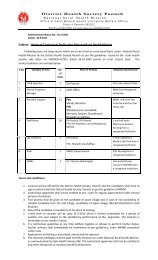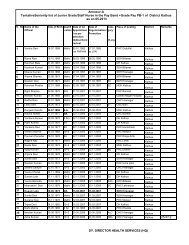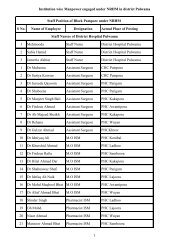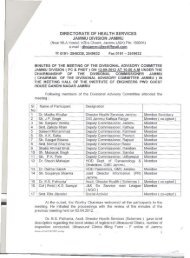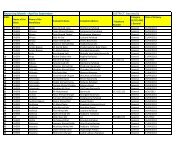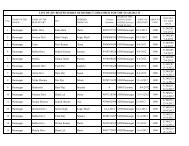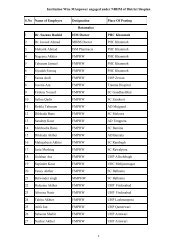Guidelines For Operationalising First Referral Units - National Rural ...
Guidelines For Operationalising First Referral Units - National Rural ...
Guidelines For Operationalising First Referral Units - National Rural ...
You also want an ePaper? Increase the reach of your titles
YUMPU automatically turns print PDFs into web optimized ePapers that Google loves.
• A minimum bed strength of 20-30. However, in difficult areas as the North-East<br />
States and the under-served areas in the EAG States, this could be relaxed to 10-12<br />
beds initially.<br />
• A fully functional operation theatre equipped for undertaking anaesthetic and<br />
emergency surgical procedures including Caesarean Sections and Laporotomies.<br />
• A fully operational Labour Room.<br />
• An area earmarked and equipped for New-born Care in the Labour Room and<br />
also in the ward.<br />
• A functional laboratory with facilities for all essential investigations.<br />
• Blood storage facility as per the guidelines issued by Govt. of India (GoI).<br />
• 24-hour water supply.<br />
• Arrangements for waste disposal.<br />
• Regular electricity supply with back-up arrangements to ensure uninterrupted supply<br />
to the operation theatre and labour room, cold chain and blood storage facility.<br />
• Telephone connection.<br />
• Ambulance (owned or arranged through local hiring).<br />
3.2 Selection of sites<br />
3.2.1 Under the RCH Programme funds were provided for civil works related to<br />
operationalisation of operation theatre, labour rooms and provision of regular water<br />
supply etc. at the CHCs and district hospitals. Similarly, civil works have been<br />
undertaken at many sub-district facilities as part of the Health Systems Projects in the<br />
concerned States. It is expected, therefore, that the physical infrastructure is already in<br />
place in many sub-district health facilities in every district. This should be taken into<br />
account while carrying out the selection process.<br />
3.2.2.However, situations could arise where the previous investments for infrastructure<br />
strengthening may not have been made in facilities which are otherwise optimally<br />
located and are more likely to attract specialised manpower than the facilities which<br />
were not taken up for such strengthening. <strong>For</strong> example, investments made to upgrade a<br />
CHC located within a few kilometers of the district hospital may not lead to much<br />
improvement in the availability of emergency services because (a) the people are likely<br />
to by pass it and go to the district hospital and (b) the staff posted at such facility would<br />
tend to stay in the district headquarter.<br />
3.2.3 The objective of ensuring proper selection should be to develop a network of 3-4<br />
facilities in the district in such a way that these together with the district hospital can<br />
ensure that all emergency cases in the district can access the nearest facility within a<br />
maximum travel time of 1 hour.<br />
Equipment: Review past receipts<br />
4.1 Twelve types of equipment kits (Kit-E to Kit-P) were designed under the CSSM programme<br />
(See Box-2 below) and supplied to the States. Detailed facility surveys carried out in some<br />
places have indicated that substantial part of these supplies may still be lying unused in<br />
some CHCs which do not have the requisite physical infrastructure and/or the necessary<br />
human resources for utilizing the equipment. Some equipment for blood storage have<br />
also been supplied under the Aids Control Programme by NACO to a number of subdistrict<br />
facilities. Similarly, States covered under the Health Systems Projects have also<br />
procured and supplied equipment for the district and sub-district level facilities.<br />
Box-2: Equipment kits supplied under CSSM Programme<br />
Kit-E: Standard Surgical Set-I (instruments) FRU<br />
Kit-F: CHC Standard Surgical Set-II<br />
Kit-G: IUD Insertion Kit<br />
Kit-H: CHC Standard Surgical Set-III<br />
Kit-I: Normal Delivery Kit<br />
Kit-J: Standard Surgical Set IV<br />
Kit-K: Standard Surgical Set-V<br />
Kit-L: Standard Surgical Set VI<br />
Kit-M: Equipment for Anaesthesia<br />
Kit-N: Equipment for Neo-natal Resuscitation<br />
Kit-O: Equipment for Laboratory Tests and Blood Transfusion<br />
Kit-P: Materials Kit for Blood Transfusion<br />
4.2 It is clear that an assessment needs to be carried out as part of the process of<br />
operationalising FRUs so that the equipment already available in a given district can be<br />
taken into account while determining the requirement of equipment. A stock taking at<br />
the district level will thus be a necessary exercise and will facilitate shifting of the<br />
equipment lying un-utilized at some facilities to those facilities where these may be<br />
required. Details of the various equipment kits is in Annexure IV.<br />
Human resources: Re-deployment and multi-skilling<br />
5.1 Policy options for human resource management<br />
5.1.1 The community health center was envisaged to be a fully functional FRU (defined to<br />
mean a facility providing full range of FRU services including C-section, along with<br />
facilities for handling other medical emergencies) and, accordingly, a minimum<br />
strength of 4 medical officers (who are either qualified or especially trained to work as<br />
surgeon, obstetrician, physician and pediatrician) was recommended. Facilities<br />
selected for operationalising FRU services should, therefore, aim to provide a similar or<br />
increased strength of medical personnel. In addition, adequate number of nursing staff<br />
to work in Operation Theatre, Labour Room and In-patient wards will also need to be<br />
carefully determined.<br />
5.2 Re-deployment & multi-skilling<br />
5.2.1 Re-deployment of the resources existing within the districts is one of the important step.<br />
This has been gainfully done in West Bengal. Based on a review, the State Government<br />
of West Bengal announced an infrastructure rationalization and manpower redeployment<br />
policy with a view to improve institutional care in the State. The key features<br />
of the policy announcement are as follows:<br />
• Strengthening of Block PHCs (BPHCs) and PHCs will be done in a need based<br />
manner after actual assessment for each individual institution. This would include<br />
rehabilitation of the buildings, provision of new equipment as well as posting of<br />
additional manpower.<br />
• All the block PHCs shall have minimum 30 indoor beds with complete facilities for<br />
institutional delivery and usual indoor treatment care.<br />
• Efforts will be made to provide same facilities in the BPHCs as are available in rural<br />
- 4 -<br />
- 5 -



